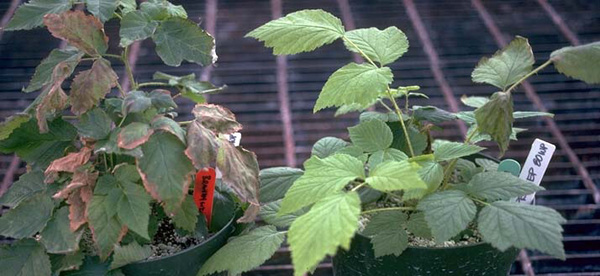Browning along the edges of raspberry leaves can be caused by several factors:
It is difficult to distinguish between causes based on symptoms alone. One must consider several possibilities to determine the cause.
Herbicide injury – some varieties are sensitive to herbicides. Princep and Sinbar are most likely to cause marginal burning.


If root uptake occurs, veinal or interveinal yellowing/necrosis also may occur.

In the photo of two raspberry plants side-by-side, both varieties were treated with the same rate of Princep herbicide. ‘Royalty’ purple raspberry is particularly sensitive.

Overfertilization – fertilizer burn can occur when excessive chloride fertilizers (e.g. muriate of potash) or high rates of nitrogen fertilizers (especially ammonium sources) are applied.
Nutrient deficiency – Potassium deficiency can cause marginal burning. Many other nutrient deficiencies also cause marginal burning, unlike many other plants where symptoms of various deficiencies are distinctive.
Drought – Raspberry leaves may begin to die from drought, but recover upon watering, leaving the edges of leaves brown.
Diseases associated with cane or lateral death – browning of leaves is one of the first symptoms exhibited by a dying cane or lateral.
Use these resources if you need additional help with diagnosis and to find solutions to your problem.


